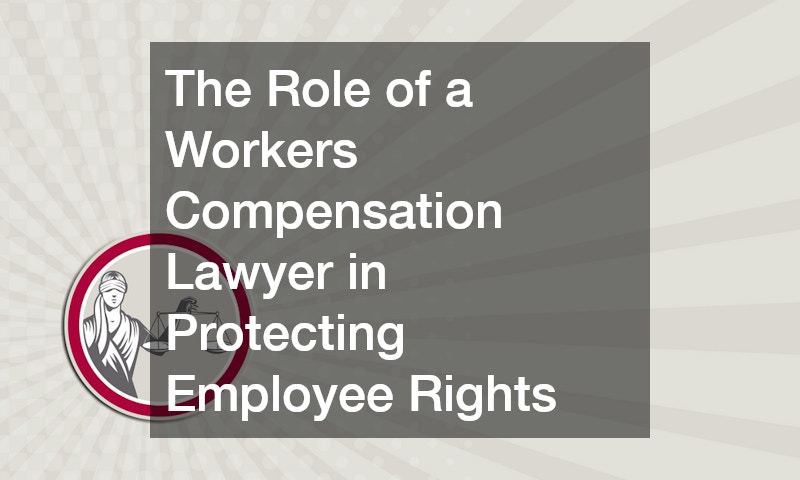
Being a worker means having a steady source of income and financial stability. However, it also means managing your finances and ensuring you have enough money to cover all your expenses. It also means being part of accidents, illnesses, or other unexpected events that can disrupt your income and leave you financially vulnerable. This is where workers comp claim comes in.
Common Types of Workers Compensation Claims
It’s important to know that different types of workers compensation claims are available to employees. This can help benefit you if you find yourself in a situation where you cannot work due to an injury or illness related to your job. Here are some common types of workers comp claim:
Slip and Fall Accidents

Slip and fall accidents are among the most prevalent reasons for workers comp claims. These incidents occur when employees slip, trip, or fall on the job due to unsafe working conditions, such as wet floors, cluttered walkways, or inadequate lighting. The aftermath of these accidents can range from minor injuries, such as bruises and sprains, to more severe conditions, like fractures or head injuries, all of which can inhibit an individual’s ability to perform their job.
When confronting such circumstances, seeking guidance from experienced workers compensation lawyers becomes crucial. These legal professionals specialize in navigating the complexities of workers comp claim processes, ensuring that affected individuals receive the rightful compensation for their injuries. Employees must understand their rights and the benefits available through workers’ compensation to mitigate the financial strain caused by work-related injuries.
Slip and fall accidents are among the most common types of workers’ compensation claims, emphasizing the significance of maintaining safe working environments for all employees. If you are in such a situation, seeking legal assistance from workers’ compensation lawyers is essential to ensure fair compensation for your injuries. So remember, if you’ve been injured on the job due to slip and fall accidents, don’t hesitate to take action and protect your rights.
Legal Support for On-the-Job Injuries
In workplace accidents, the role of personal injury attorneys becomes invaluable, especially when navigating the complexities of a workers comp claim. These legal experts are not just advocates; they are your frontline in ensuring that justice is served following an on-the-job injury. With their specialized knowledge, personal injury attorneys guide victims through the convoluted legal pathways that might otherwise overwhelm an individual already burdened by physical pain and financial uncertainty.
The process begins with a comprehensive analysis of the incident to ascertain the validity and potential value of the claim. Recognizing the nuanced differences between personal injury law and workers’ compensation law is critical, as it informs your attorney’s strategy. Unlike general personal injury scenarios where negligence needs to be proven, workers’ comp claims typically do not require the employee to demonstrate their employer’s fault. This distinction significantly influences the approach and potential outcomes of the case.
Understanding Your Rights After a Workplace Injury

After sustaining an on-the-job injury, it’s pivotal to clearly comprehend your entitlements and the steps you should undertake to secure them. The aftermath of a workplace injury is a critical period where understanding your rights can significantly impact the outcome of your workers compensation claim. This claim is a legal avenue designed to provide financial assistance and support to injured employees while performing their job duties, ensuring they receive medical care and compensation for lost wages during their recovery.
Navigating through a workers comp claim involves multiple stages, including reporting the injury to your employer, seeking medical evaluation, and, potentially, legal proceedings. It’s crucial at this juncture to be aware that specific timelines and requirements govern each step, and failure to adhere to them can jeopardize your claim. Knowledge is power in these circumstances, and having a thorough understanding of your rights and obligations under the workers’ compensation system empowers you to advocate for your needs effectively.
Remember, while workers’ compensation is designed to be a no-fault system, making it unnecessary to prove your employer’s negligence, challenges can still arise. Disputes over the severity of the injury, the necessity of medical treatments, or the connection of the injury to your work are common. Here, the expertise of a seasoned attorney becomes invaluable, assisting you in overcoming these hurdles to ensure that your rights are upheld and that you receive the compensation you rightfully deserve.
Filing a Claim for Work-Related Injuries
When considering the pivotal step of filing a claim for work-related injuries, it becomes imperative to seek the assistance of a local personal injury attorney specializing in workers’ comp claims. This legal partnership can drastically alter the trajectory of your case. A proficient attorney not only aids in accurately navigating the complexities of the claim process but also ensures that all procedural requirements are met within specified deadlines. The expertise of such a lawyer in interpreting the nuances of workers’ compensation law guarantees that every facet of your case is meticulously addressed. From collecting and presenting necessary medical evidence that substantiates the injury to negotiating with insurance companies on your behalf, the role of a dedicated attorney is multi-faceted. They become your advocate, prioritizing your right to fair treatment and compensation.
Home Workplace Hazards and Claims

In the modern era, where remote work has become increasingly prevalent, the definition of workplace hazards has expanded to include the home environment. This shift necessitates a broader understanding of workers’ compensation claims, especially for home contractors who might face unique risks outside traditional office settings. When discussing home workplace hazards, it is essential to consider factors such as ergonomic risks, electrical safety, and the use of household spaces for work-related activities, all of which may contribute to the potential for injury.
Given this context, filing a workers comp claim for injuries sustained in a home office setting can be particularly nuanced. Home contractors must demonstrate that the injury is directly related to work activities despite the domestic setting. This proves the importance of maintaining clear boundaries and documentation of work hours and tasks, as these elements play a critical role in substantiating claims. Furthermore, navigating the complexities of such claims may require specific legal expertise, underscoring the value of enlisting a knowledgeable attorney. An experienced lawyer can provide crucial guidance in proving the work-related nature of the injury, a pivotal factor in securing compensation.
Roofing Dangers and Workers’ Compensation
Roofing stands out as one of the most hazardous jobs in the construction industry, presenting unique risks to those involved. Being a roofing contractor involves working at significant heights, exposure to extreme weather conditions, and handling heavy or sharp materials, substantially increasing the likelihood of accidents and injuries. The precarious nature of roofing can lead to falls, among the leading causes of serious workplace injury or fatality. Additionally, roofers are at risk of injuries from the repetitive lifting motion, thermal burns from hot materials, and even potential harm from electrical contact.
In light of these dangers, the process of filing a workers comp claim for injuries sustained while roofing is critical. The claim must establish the direct link between the injury and the roofing work undertaken, which is often straightforward given the inherent risks of the job. However, the complexity arises in proving the injury’s severity and impact on the contractor’s ability to work. This is where the expertise of a skilled attorney becomes invaluable. A lawyer with experience in workers’ compensation can adeptly navigate the claim process, ensuring that all the necessary documentation is in order and advocating for the full extent of benefits owed to the injured roofer. Their knowledge can be instrumental in securing compensation that accurately reflects the injury’s impact on the contractor’s professional and personal life.
The Role of HVAC in Workplace Accidents

HVAC (Heating, Ventilation, and Air Conditioning) face unique hazards in their line of work, which can lead to workplace accidents warranting a workers comp claim. Working on HVAC systems often requires the handling of refrigerants, which can result in burns or frostbite if not appropriately handled. Additionally, HVAC technicians frequently work in tight, confined spaces such as attics and crawl spaces, where they are at risk for injuries related to poor ergonomics, and they might also encounter harmful dust or mold, posing significant respiratory hazards. Electrical risks are another concern, as installing or repairing HVAC equipment involves working with live electrical components, increasing the chances of shocks or electrocution.
Similar to the complexities experienced by roofing contractors in filing a workers comp claim, HVAC contractors must also clearly establish the connection between their work and their injury. This task can be particularly challenging when injuries develop over time, such as those caused by repetitive motions or long-term exposure to harmful substances. The need for detailed medical evidence and documentation outlining the extent of the injury and its impact on the contractor’s ability to perform future work is crucial. Leveraging the expertise of a knowledgeable attorney can significantly ease the process, helping to ensure that all requirements for a successful claim are met and that the injured HVAC contractor receives the compensation they rightly deserve. This legal support is invaluable in navigating the intricacies of workers’ compensation claims, advocating for the contractor’s rights, and securing a fair outcome.
Renovations and Worker Safety
Safety always takes precedence in the realm of home improvements, especially for those in the remodeling and renovation profession. The role of a home remodeling contractor is multifaceted, encompassing a wide range of activities from structural modifications to aesthetic enhancements. These tasks, while transforming homes into more functional and visually appealing spaces, come with their unique set of hazards. Just as detailed planning is essential for successfully completing a remodel, so is the attention to safety measures to protect those who do the work.
When injuries occur despite precautions, navigating the process of filing a workers comp claim can become an unexpected part of the job for a contractor. This process is not just a legal formality but a necessary step to ensure contractors receive the support and compensation required for recovery and a return to work. Given the diverse nature of home remodeling work, ranging from electrical installations to structural demolitions, the risks are equally varied. Recognizing the connection between the specific nature of the injury and the work performed is crucial in these claims. Similar to fields such as HVAC or roofing, challenges arise in proving that an injury is work-related, especially when symptoms manifest over time or result from cumulative exposure to hazardous materials.
Gutter Work Injury Claims
Gutter installation services, while seemingly straightforward, involve tasks that pose significant risks to workers. The work typically requires contractors to operate at heights, handle sharp tools, and sometimes manage heavy materials, which can lead to potential injuries. Filing a workers compensation claim becomes crucial for the injured party when such incidents occur. This step is not merely procedural but vital to securing needed financial support for medical expenses and lost wages during recovery periods.
Unlike other renovation tasks that might occur on solid ground, the elevated nature of gutter work exponentially increases the risk of falls, one of the most common causes of serious work-related injuries. Additionally, the exposure to changing weather conditions can add another layer of danger, affecting both the safety of the worker and the ease of the task at hand. Given these factors, establishing the work-relatedness of injuries in gutter installation is paramount when pursuing a compensation claim. It requires a detailed understanding of the job’s hazards and a comprehensive documentation process to substantiate the injury’s link to the workplace activity.
Garage Door Installation Injuries
Garage door installation is a highly technical and precision-driven task requiring expertise and caution. Unfortunately, professionals working for a garage door company are not immune to the physical risks that the job entails. Like any construction or installation job, the stakes are high, and the room for error is minimal, especially when dealing with heavy panels, springs under tension, and electrical components. When injuries occur, filing a workers comp claim becomes essential for the injured worker. This step is crucial for not only acknowledging the injury as work-related but also facilitating access to compensation that covers medical treatments and compensates for any loss of earnings during the rehabilitation period.
Injuries during garage door installation can range from minor cuts and bruises to more severe incidents like fractures or electrical shocks, demonstrating the varied dangers in this line of work. Given the complexities involved, including the operation of heavy machinery and the necessity for precise alignment and installation, workers must always be vigilant. Therefore, should an injury occur, it is vital to demonstrate a clear linkage between workplace activities and the resultant injury, ensuring that the worker’s rights to compensation are rightfully preserved. The intricacies of proving these claims emphasize the importance of meticulous documentation and a profound understanding of the job’s risks, underscoring the essential nature of safety protocols and preventive measures.
Workers comp claim is an essential knowledge you need to learn as an employee. From filing the claim to receiving compensation, it is a process that can be daunting and time-consuming. However, it can be a smooth and efficient experience with the right knowledge and guidance. As an employee, ensure you know the most common types of injuries in your specific line of work, as well as the safety protocols and preventive measures to minimize risks.



